USE SHORT SENTENCES— THE RULE OF TWENTY
Look at any piece of writing, and if you see more than three lines of typing without a period or semi-colon, chances are you’ll start getting confused. More than twenty words in a sentence leads to reader confusion. So reread what you’ve written, note with a wavy line in the margin where you see lengthy sentences, and go back to revise them. There are several ways to trim excess writing fat: cut prepositional phrases, look for restatements that add nothing to your writing, and, avoid the passive voice.
Cut prepositional phrases such as: along the lines of, as of this date, at the present time, and in the event that; instead, use like, today, now, and if. Locate a prepositional phrase, and ask yourself if you can use one word where you’ve written three. Whenever you see the preposition of, see if you can use the possessive to eliminate a couple of words:
Bloated: The meeting was held in the office of the president.
Trimmed: The meeting was held in the president’s office.
You also can trim language by looking for obvious restatements or for words that have a double meaning:
Redundant: The staffers got together and did some advance planning; that is, they put their heads together to find solutions.
Efficient: The staffers met and planned strategies.
Finally, look again for the passive voice. A prepositional phrase usually introduces it, and by eliminating the phrase you can trim back the sentence:
Passive: The market is dictated by the large investors.
Active: Large investors affect the market.
The first sentence contains eight words, the second only five—that’s a large savings in words.
